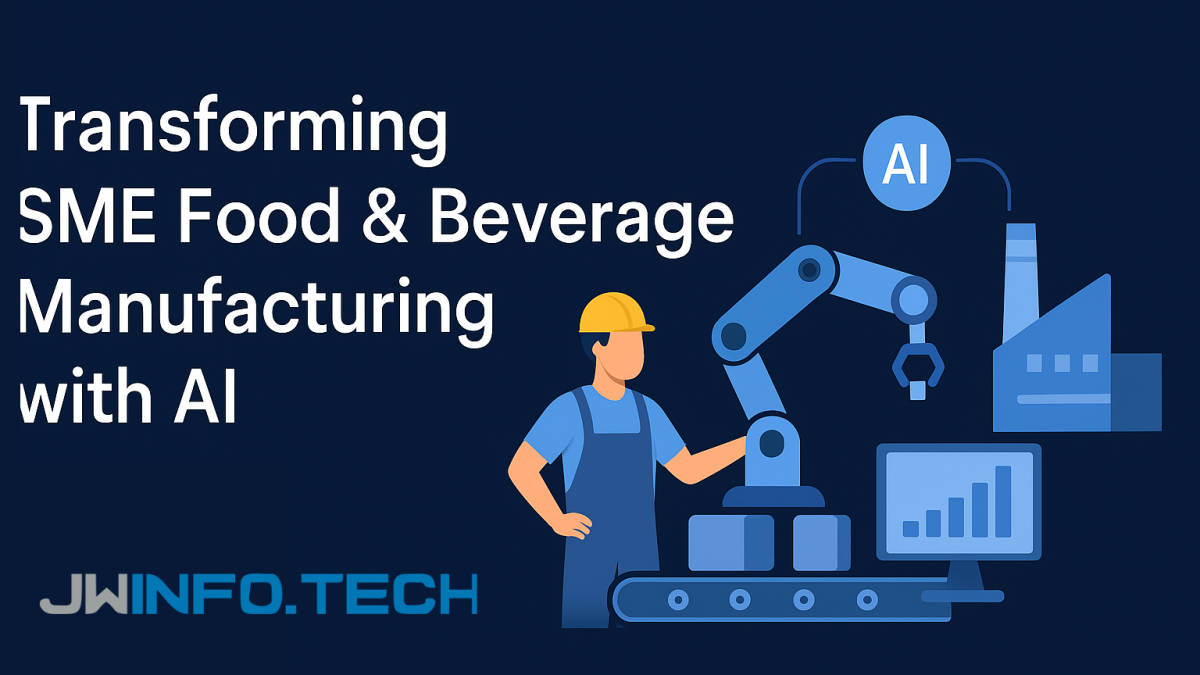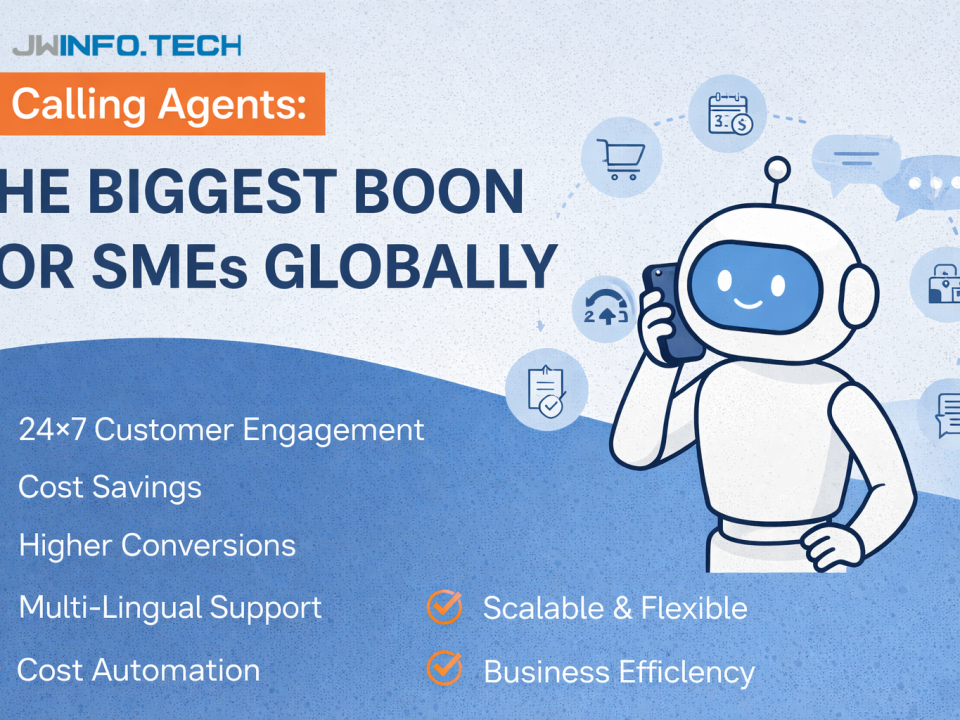Transforming SME Food & Beverage Manufacturing with AI: A JW Infotech Case Study

Agentic AI + Voice-Enabled CRM: Transforming SME Workflows
September 24, 2025
Reinventing Carbon Markets with AI: A JW Infotech Perspective on Carbon Reduction Innovation
October 8, 2025Small and mid-sized food & beverage (F&B) manufacturers face mounting pressure to cut waste, maintain quality, and reduce downtime — often with limited budgets and legacy equipment. This case study shows how JW Infotech’s AI-led approach (automation + predictive maintenance + inventory optimization + AI insights) can deliver measurable improvements in efficiency, cost and time-to-market for SME food factories. The trends backing this approach are visible across multiple leading food manufacturers and industry reports.
Context & challenge (SME perspective)
Typical SME F&B challenges:
- Frequent unplanned downtime that disrupts production runs and increases scrap.
- Manual inventory counting and poor visibility into per-SKU shelf life, driving waste.
- Limited data capture on machine health and process parameters, meaning reactive maintenance.
- Small teams juggling production, compliance, and supply issues with little analytics support.
These pain points are consistent with industry analyses that show AI adoption in F&B is focusing on predictive maintenance, supply-chain & inventory intelligence, and automation to meet sustainability and quality requirements.
Solution overview (JW Infotech approach)
JW Infotech designed a modular, SME-first solution that combines:
- Edge + sensor retrofits for existing process equipment (vibration, temp, humidity, energy meters).
- Predictive maintenance (ML models) trained on vibration, motor current, and temperature to forecast failures and schedule interventions.
- Inventory optimization models that fuse POS / production schedule / shelf-life / weather / local events to minimize spoilage and stockouts.
- Automation & workflow orchestration (low-code / RPA for manual handoffs, digital checklists for HACCP/food-safety).
- Dashboarding + prescriptive alerts for plant managers, procurement and finance.
This model reflects the primary value areas reported in industry sources: predictive maintenance, demand forecasting & inventory optimisation, and automation for sustainability and compliance.
Roles & responsibilities (multiple-role view)
- Plant Manager (operational role)
Goal: increase line uptime and reduce scrap. Actions: approve sensor retrofit, validate alarms, lead 1st-line corrective actions. Benefit: fewer emergency stoppages; better shift handovers. - CTO / Tech Lead (strategy & integration)
Goal: ensure systems integrate with ERP and production planning. Actions: select edge hardware, define data schema, ensure cybersecurity and cloud/on-prem balance. - Data Scientist / ML Engineer (value creation)
Goal: build predictive models for failures and demand. Actions: label failure events, train models, monitor drift, produce actionable thresholds. - Procurement / Supply Lead (inventory optimization)
Goal: reduce spoilage and working capital. Actions: implement AI demand forecasts, set dynamic reorder points tied to shelf-life profiles. - CFO / Finance (business case & ROI)
Goal: validate capex vs opex, model ROI and working capital improvements. Actions: track OEE uplift, waste reduction, and maintenance savings. - Quality & Compliance Lead
Goal: ensure HACCP / traceability. Actions: map sensor and batch data to compliance reports; reduce recall risk.
This role matrix ensures the technology translates to operational outcomes without creating a “data silo.” Industry adopters follow similar cross-functional approaches.
Implementation: tech & process steps (practical roadmap)
- Discovery (2–4 weeks) — map process flows, asset criticality, and data availability.
- Pilot (6–8 weeks) — install sensors on 1–2 critical lines; run models for predictive maintenance and demand forecasting on a subset of SKUs.
- Scale (3–9 months) — roll out across lines; automate workflows to integrate ML outputs with maintenance scheduling and procurement.
- Optimize (ongoing) — monitor model drift, expand datasets (e.g., environmental sensors) and refine causal rules for false-positive reduction.
Industry reports show companies gain traction fastest when they pilot predictive maintenance and inventory optimization together because they address both uptime and waste simultaneously.
Outcomes & KPIs (what to expect)
Based on industry benchmarks and real-world examples, expected improvements for a successful deployment include:
- Unplanned downtime reduced by 20–50% through predictive alerts and timely interventions.
- Inventory waste/spoilage reduced by 10–30% via demand forecasting and dynamic reorder points.
- Inventory counting & accuracy improved (example: retail & stores using AI inventory counting show order-of-magnitude improvements in counting frequency and accuracy). Real implementations (e.g., Starbucks) demonstrate how automated counting streamlines replenishment.
- Throughput / OEE uplift from process automation and reduced stoppages — typically single-digit to low-double-digit % improvements initially, compounding over time.
Note: exact results depend on asset condition, data quality, and organizational adoption.
Case examples & validating signals (industry evidence)
- Siemens and other industrial automation leaders document clear benefits from predictive maintenance in bottling and processing lines (reduced downtime, higher throughput).
- Global players (Nestlé, PepsiCo, Land O’Lakes) are publicly investing in AI to optimize supply chains, waste reduction and product innovation — signaling the strategic direction for the whole industry.
- Smart factories and automated bakeries (e.g., recent smart-factory investments in Australia) illustrate that even mid-market manufacturers can scale AI + robotics to double capacity while creating higher-skilled roles.
These signals show the shift isn’t limited to large enterprises — proven approaches and vendors are making it accessible for SMEs.
Risks, mitigations & governance
- Data quality & sparse failure labels — mitigate with focused sensor selection, synthetic data augmentation, and expert rules for initial months.
- Change fatigue — mitigate via phased rollout, local champions, and clear KPI dashboards.
- Vendor lock-in & cybersecurity — prefer open standards (OPC-UA), containerized ML models, and contractual SLAs for data portability.
- HACCP and regulatory traceability — ensure the solution maps to audit trails and batch-level traceability.
Recommendations & next steps (SME playbook)
- Start with a critical asset pilot for predictive maintenance (highest ROI).
- Parallelly run SKU-level demand forecasting for top 20 SKUs to cut immediate waste.
- Build a cross-functional team with plant, procurement, and finance.
- Use pay-per-outcome or phased pricing (SaaS + small hardware fee) to align capex constraints.
- Track OEE, spoilage %, days of inventory, and maintenance cost per MT as the top 4 KPIs.



